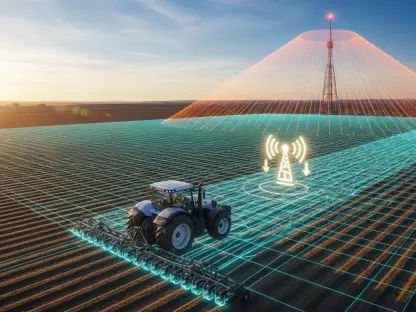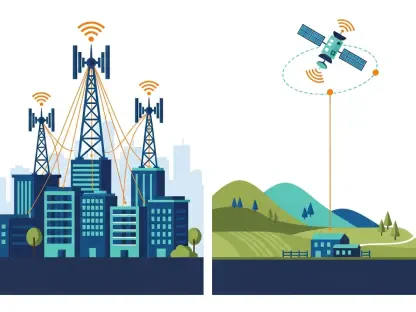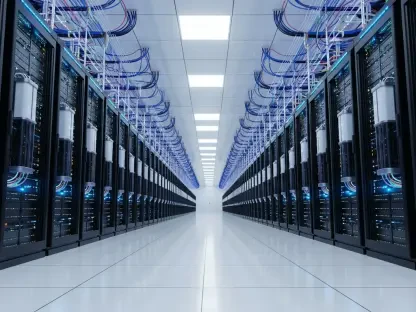AI is set to revolutionize the telecommunications industry, with transformative potential that will be on full display at the Optical Fiber Communication Conference and Exhibition (OFC) 2025. Held from March 30th to April 3rd at the Moscone Center in San Francisco, the event commemorates its 50th anniversary by shining a spotlight on the revolutionary role artificial intelligence (AI) is playing in optical networking and telecommunications. With a fascinating lineup of technical sessions, plenary speakers, and expert panels lined up, OFC 2025 promises to be a nexus for deep exploration and indispensable knowledge about the future of telecom.
Keynote Insights
AI’s Impact on Data Center Networking
Dr. Pradeep Sindhu from Microsoft will deliver insights into AI’s impact on data center networking and compute efficiency. Data centers serve as the backbone of modern telecommunications infrastructure, and AI’s ability to optimize network traffic and manage enormous computational loads can yield significant performance gains. As these digital hubs continue to grow in complexity, AI can help mitigate inefficiencies and bolster processing speeds.
Dr. Sindhu’s presentation is expected to highlight how AI technologies can streamline operations within data centers, potentially helping enterprises save both time and resources. His talk will delve into AI’s capability to predict network issues before they impact service quality sharply, thereby offering preemptive solutions. These advancements are instrumental in not only improving the functionality of data centers but can also lead to lowered operational costs—a critical factor in today’s competitive business landscape.
Advancements in Free-Space Optical Communications
Dr. Bryan Robinson from MIT Lincoln Laboratory will explore advancements in free-space optical communications and their applications within AI-driven networks and quantum communication. Free-space optical communication, relying on light to transmit data between points without the need for physical fiber, holds immense promise for faster and more secure data transfer. Dr. Robinson’s research sheds light on the transformative potential of integrating such technologies with AI systems to foster groundbreaking innovations in telecommunications.
Attendees will be treated to an in-depth examination of how free-space optical communications can elevate network efficiency to unprecedented levels. Discussions will encompass AI’s role in enhancing signal integrity and allowing for adaptive response mechanisms to environmental conditions. The intersection of AI and free-space optical communications may just pave the way for future innovations critical for developing next-gen networks.
Innovations in Photonics Technologies
Professor Kei May Lau from the Hong Kong University of Science and Technology will discuss innovative photonics technologies aimed at augmenting high-speed optical systems. Photonics, the science of using light to transmit information, has critical implications for communication networks’ speed and reliability. Professor Lau’s expertise sheds light on how advanced photonics can meet burgeoning demands for rapid data transmission, thereby catalyzing the next wave of telecommunication breakthroughs.
Anticipation surrounds the unveiling of advanced photonic devices capable of supporting ultra-fast and highly reliable communication networks. These innovations are deemed necessary as the world increasingly veers toward higher data consumption. Her session is poised to illustrate various novel applications, such as using photonics to enhance fiber optics’ efficiency and integrating AI to maximize performance further, making potential leaps in optical system speeds genuinely exciting.
AI-Powered Transformations
Generative AI for Network Operations
The conference will delve deeply into the burgeoning field of generative AI, particularly concerning its application in network operations. Generative AI describes machine learning models that can generate new data approximating a given set. This feature is particularly useful in telecom for predictive maintenance, traffic optimization, and automated network management.
Discussions on generative AI will reveal how these models can address operational inefficiencies within networks, effectively predicting points of failure or congestion before they occur. Industry experts will argue that using AI for such tasks could significantly enhance networks’ reliability. The panel will also explore how generative AI can help manage dynamic network environments, leading to more efficient use of resources and boosting overall performance.
Large Language Models and Predictive Maintenance
Another hot topic at OFC 2025 is the application of large language models (LLMs) within telecommunications infrastructure. LLMs can analyze large amounts of data to extract actionable insights, making them valuable for predictive maintenance and other operational tasks. These models can effectively discern patterns and predict anomalies that may signify impending issues, allowing proactive measures to be taken.
Experts will present case studies demonstrating how LLMs have successfully been implemented in network operations. Their role in making communication infrastructure more intelligent and responsive will be discussed, alongside the tangible benefits of reduced downtime and costs associated with unplanned maintenance. Attendees will gain insights into creating a predictive maintenance framework based on extensive data analysis using LLMs.
Enhancing Computational Efficiency
Photonic AI Accelerators
Photonic AI accelerators are cutting-edge devices designed to enhance computational efficiency in AI-driven networks. They use photons instead of electrons for data processing, which can significantly speed up computations while using less power. This breakthrough is critical for developing more efficient and powerful telecommunications infrastructure, which will be discussed extensively at the conference.
Speakers will delve into the operational mechanics and benefits of photonic AI accelerators. By accelerating machine learning computations, these devices promise faster decision-making capabilities in networks, raising the bar for performance expectations. The focus will be on how these accelerators can be integrated into existing infrastructure and the tangible benefits for network operators, including reduced energy consumption and improved processing speeds.
Quantum Key Distribution (QKD) and Post-Quantum Cryptography (PQC)
Security remains a paramount concern in telecommunications. OFC 2025 will highlight Quantum Key Distribution (QKD) and Post-Quantum Cryptography (PQC) as forefront technologies in enhancing cybersecurity. QKD employs quantum mechanics principles to enable secure communication, preventing unauthorized access by employing quantum bits.
Sessions will explore integrating QKD within optical networks to offer unparalleled security. Attendees will learn about efficient implementation, the challenges, and how AI can enhance these security measures. Post-Quantum Cryptography will also be on the agenda, showcasing encryption methods robust enough to withstand quantum computer attacks. Together, QKD and PQC are set to forge a new era of secured communications, reducing vulnerabilities in increasingly complex telecom networks.
Adaptive Network Architecture
Multi-Band Transmission and Hollow-Core Fibers
Emphasizing adaptable and cost-effective network architectures, OFC 2025 will cover the latest developments in multi-band transmission and hollow-core fibers. Multi-band transmission techniques enable optical networks to simultaneously send data over multiple frequency bands, significantly boosting capacity and flexibility.
Sessions will discuss how AI can be leveraged to manage these complex transmission frameworks, optimizing performance and reducing latency. Hollow-core fibers, known for their low latency and high-speed capabilities, will also be explored. Their structural design allows light to travel faster compared to traditional fibers, making them suitable for real-time applications. Attendees will delve into how these fibers can be configured within multi-band transmission systems, delivering a comprehensive look at cutting-edge network architecture.
ICAS: Integrating Communication and Sensing
Integrating Communication and Sensing (ICAS) will be another pivotal topic, focusing on how the fusion of these domains can elevate network capabilities. ICAS can facilitate smarter infrastructure, whereby networks can sense and react to environmental conditions in real-time. This level of adaptability is crucial for developing autonomous networks and smart cities.
Presentations will highlight the technological frameworks necessary for fostering ICAS, underpinning their transformative potential in areas like traffic management and fault detection. By integrating advanced sensing capabilities, networks become more self-sufficient and responsive. Sessions will explore case studies and real-world applications, providing invaluable insights into developing and deploying ICAS technologies effectively.
Strategic Insights
AI-Powered Network Automation
AI-powered network automation stands at the forefront of next-gen telecom innovations. Automating network operations allows for seamless management, enhanced efficiency, and minimized human intervention. The conference will discuss the technological prerequisites and the tangible benefits of fully automated network operations.
Sessions will feature in-depth analyses of machine learning algorithms employed for traffic optimization, fault detection, and predictive analytics for demand management. Each of these facets will be discussed in detail, providing attendees with a robust understanding of automating various network operations. The potential savings in both time and costs are substantial, and real-world examples demonstrating these benefits will be scrutinized.
AI Integration with Quantum Networks
A paramount topic of interest will be AI integration with quantum networks. Quantum networks promise unprecedented data transfer speeds and security enhancements, while AI offers intelligent operational management. Together, they can create wickedly capable networks, paving the road to the telecom industry’s future.
Discussions will revolve around how AI can optimize quantum communication protocols, improving efficiency and reducing error rates. The potential for disruptive innovations and the practical challenges of integrating AI with quantum networks will be key points of discussion. Attendees will leave with a comprehensive understanding of these cutting-edge technologies’ roles in shaping future telecommunications networks.
The Future of Optical Networking
Business Panels and Workshops
Presenting a holistic view on the future of AI-driven telecom innovations, business panels and interactive workshops will round out the conference. Over 600 global exhibitors are expected to showcase state-of-the-art networking solutions, defining the technological trends that will dominate the next decade. These sessions aim to bridge the gap between theoretical advancements and practical implementations.
Attendees can anticipate sessions that offer actionable insights into deploying cutting-edge AI technologies within existing networks. Business leaders will share strategic visions for a robust, AI-empowered future, while interactive workshops provide hands-on experience with emerging technologies. The goal is to equip industry professionals with the tools necessary to drive innovation within their respective organizations.
The Global Hub for AI-Powered Telecom Solutions
AI is poised to revolutionize the telecommunications industry, and this transformative impact will be prominently featured at the Optical Fiber Communication Conference and Exhibition (OFC) 2025. The event, scheduled from March 30th to April 3rd at the Moscone Center in San Francisco, celebrates its 50th anniversary by highlighting AI’s revolutionary role in optical networking and telecommunications. OFC 2025 will offer a compelling array of technical sessions, engaging plenary speakers, and insightful expert panels. Attendees can expect a deep dive into the future of telecom, exploring the latest advancements and innovations driven by AI. This conference is set to be an essential gathering for those seeking indispensable knowledge and keen insights into how AI will shape the telecom landscape in the years to come. With leading industry experts and cutting-edge discussions, OFC 2025 promises to be a pivotal event for anyone interested in the future of optical fiber technology and its potential to transform global communications.









